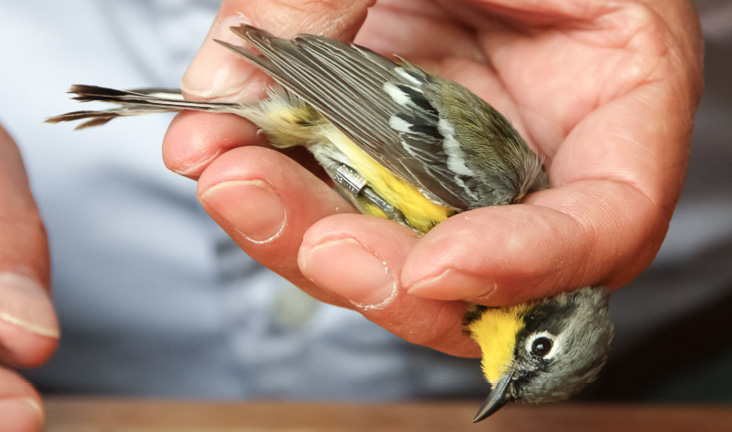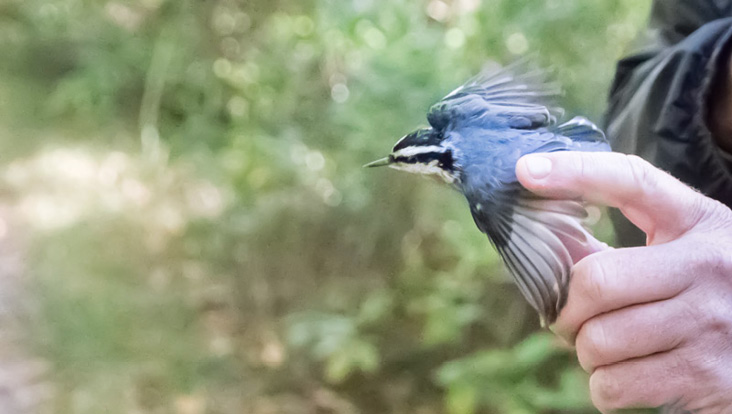Regina Harrison

A Magnolia Warbler held in a classic bander's grip, displaying its new leg band. All photographs by Pauliina Swartz.
Early morning sunlight dapples through the brushy woods as I walk along a narrow path. Eastern Towhees extol the virtues of tea and Gray Catbirds meow almost incessantly, while warblers, finches, and sparrows chip sociably to their companions. The woods of Parker River National Wildlife Refuge (PRNWR) are dense with life in spring and fall as birds prepare for or pause in their migrations to feast on Plum Island's bounty of fruits, seeds, and insects. The concentration of so many species in one place creates an ideal location for a banding station, and the path on which I walk is laced with mist nets, nearly invisible in the sunlight.
I approach a net and see movement within. A Gray-cheeked Thrush has flown into the lower part of the net as it traveled through the understory. It flutters fruitlessly as I approach. I assess how tangled the bird is. This one will not be too difficult; between two fingers I carefully grip its legs behind the heels, coax strands of net away from its claws, free the tail feathers, work loops of net away from the shoulders and flight feathers, shift my hold on the bird to a bander's grip around its neck and back that prevents its wings from flapping, and finally slip the net over the bird's head, freeing it. It is vibrantly alive in my hand, fragile yet filled with a tensile strength. I marvel that this small body will fly hundreds of miles this fall. The thrush has kept up a running commentary of protest throughout its extraction from the net but is relatively calm as I place it in a small cloth bag to bring back to the banding station. Once there, the bird will be measured, assessed, and given a metal leg band with a unique identifying number before it is released back into the woods.
The PRNWR banding station, operated by Mass Audubon Joppa Flats with permission by the refuge management, opened in 1998 and has run continuously since then under the guidance of federally licensed bird banders supported by a group of dedicated volunteers. Nets are placed along a set of backwoods paths during the peak migration times of April-May and September-October. The focus is on songbirds, but any bird that flies into a net, like the occasional Sharp-shinned Hawk, Saw-whet Owl, or even a wayward Northern Harrier, will be banded. The one exception is hummingbirds, which require a special permit and are immediately released if captured. Over the last 21 years, 50,063 individual birds have been banded, representing 126 species. An average of 1,230 individual birds are banded in every spring, and 1,061 every fall. The most frequently banded bird is the Gray Catbird, with 6,445 banded to date. Notable rarities over the years have included Ash-throated Flycatcher, Green-tailed Towhee, and Yellow-green Vireo.
On a local level, the data gathered helps the refuge staff in its habitat management by providing insight into which species are foraging and in what kind of vegetation. On a global level, researchers can use the data collected to conduct migration studies and look at changing patterns in individual species over time. That information can be used to determine the impact of climate change, whether it's an increase in formerly southern species expanding their range or former residents decreasing in number as they shift farther north in response to changing food resources and temperature conditions.

A Red-breasted Nuthatch being released after banding.
I began volunteering at the banding station in the fall of 2015, after taking a training workshop at Joppa Flats in September of that year. Novice volunteers start out by observing the experienced extractors removing birds from nets and recording data as banders process the birds. Although my description of extracting the Gray-cheeked Thrush may have sounded simple, the reality is often a complex tangle of net and wing and thigh and feather and claw, with every species offering its own unique challenge. A Brown Creeper, for example, has almost no upper leg to grasp, and those long toes get caught over and over as you work on the bird. Kinglets of both species will helicopter around in the net, making the challenge of extracting those tiny birds all the more difficult. Northern Cardinals will grab your skin in a vise grip with that strong beak and raise blood blisters, but you must calmly take it as you work to free the bird. Gray Catbirds have little balls at the base of their nails that will catch on net strands, and Eastern Phoebes are susceptible to wing strain if allowed to flap around too much. So it is important to watch, listen, and learn before trying your hand, and it is also important to know when to ask for help, because the birds' safety comes first. The recording of data is also a form of training, as you listen to the banders determine sex, measure body fat, and assess age through feather molt and wear. Although one might be technically proficient at handling birds and be able to affix a band to a bird's leg, you cannot be a bander until you are able to conduct a general assessment of a bird.
One of the real joys of the banding station for me has been getting to know the various birds as individuals of a species. They all have their own personalities and behaviors, and after I have seen them in the nets over time, I get a better sense of who that bird is. From a mechanical standpoint, understanding how a bird's wing or leg works because you have felt it stretched out in your hand gives insight into how different species and body types of birds move through the air and perch on branches. When I see a species in the field, I have a deeper appreciation of why it behaves as it does, from twirling kinglets to cocky chickadees to melodramatic catbirds. I feel more closely connected to the entire environment as I watch birds fulfilling their natures and physical beings, each fitting into their own niche as part of a complex whole.
And then there is the chance to see truly fantastic little birds up close instead of at a distance through binoculars. Spring warblers are expectedly resplendent in their finery, positively glowing in their blues and greens and yellows, but even the "little brown jobs," the sparrows, wrens, and creepers of the bird world, are wondrous mosaics of rich browns, delicate grays, russet reds, and soft buff colors when they are right in front of you. I could hardly believe a Brown Creeper was the same little mousy bird seen up on tree trunks when I first held one in my hand. They are all tiny treasures.
Because the banding station is in an area of the refuge not open to the public, visitors cannot just stop by, but Mass Audubon's Joppa Flats Education Center, PRNWR, and several area bird clubs include regular visits for adults and families to the banding station among their programs. Joppa Flats runs training sessions twice a year for those who think they might be interested in volunteering. The commitment of volunteering is not for everyone, but I highly recommend a visit to your local banding station for all birders. You will see birds in a way that you have never seen them before.
For more information on the banding station, please visit: https://www.massaudubon.org/get-outdoors/wildlife-sanctuaries/joppa-flats/about/bird-banding. Special thanks to Ben Flemer for supplying banding station data.
Regina Harrison is executive assistant and sales coordinator at Mount Auburn Cemetery, a regular volunteer at the PRNWR banding station, and an associate editor of Bird Observer. She is engaged in a long-term habitat restoration project at her home in Woburn, Massachusetts, with an emphasis on providing year-round food and shelter for birds.